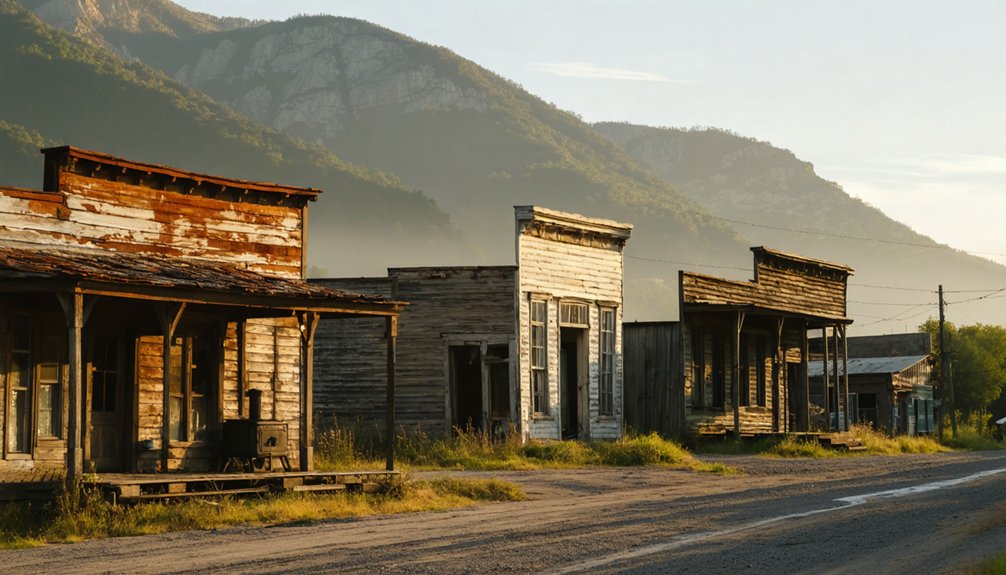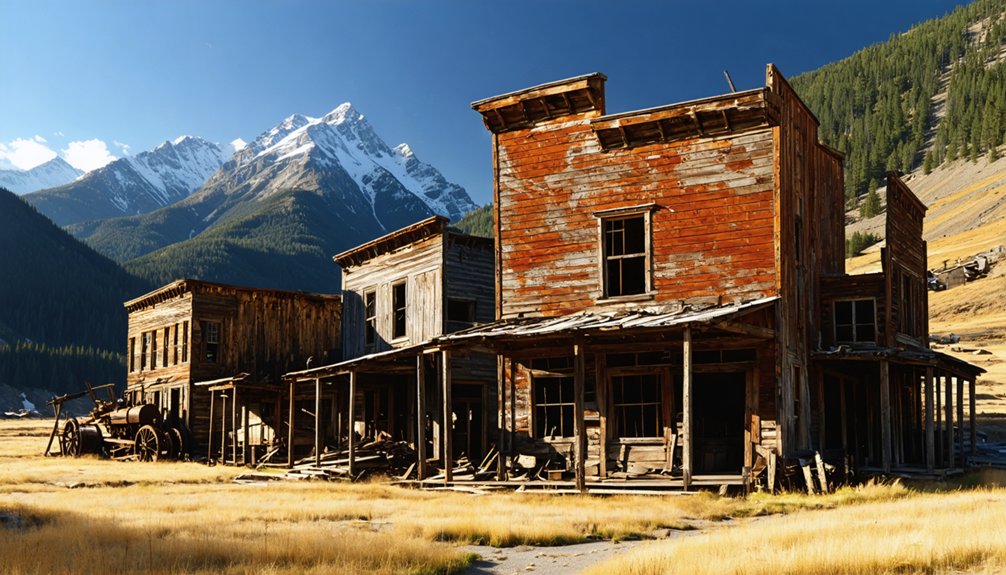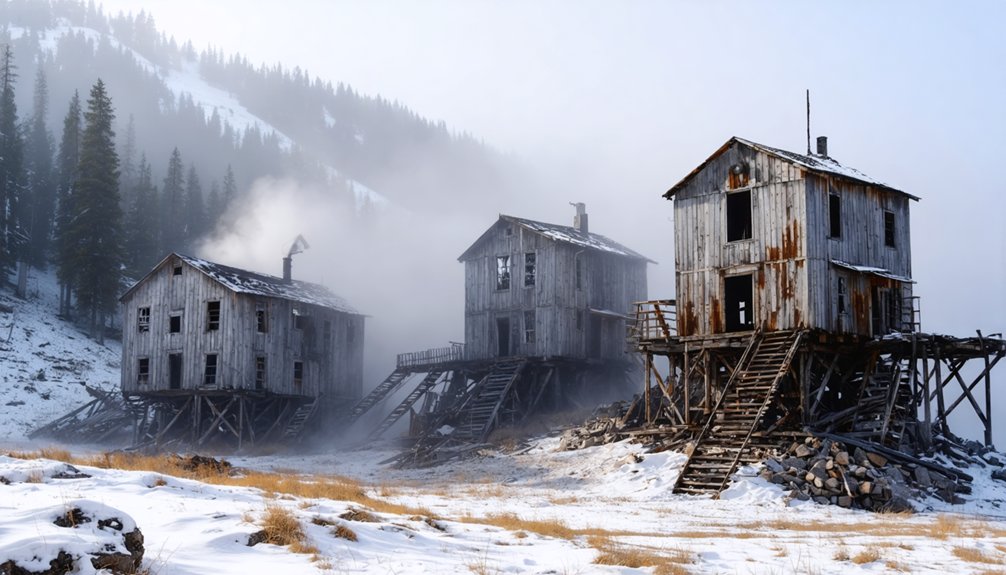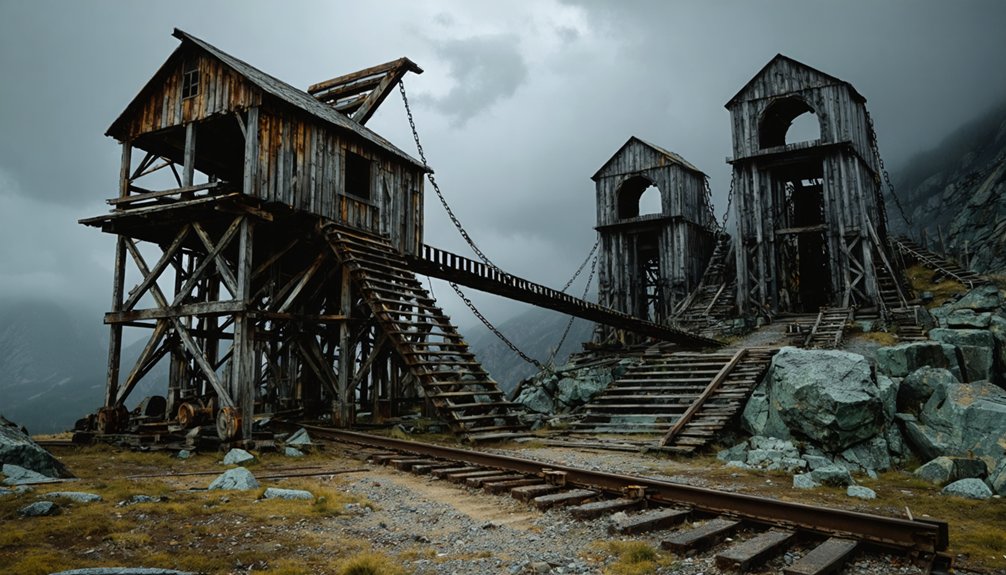Within a few hours of Denver, you’ll discover Colorado’s haunting mining ghost towns where fortune-seekers once chased golden dreams. Explore St. Elmo’s remarkably preserved storefronts, witness Gilman’s environmental cautionary tale, or wander through Dyersville’s minister-founded settlement. Don’t miss Teller City, Mount Vernon, Vicksburg, and Winfield where weathered cabins and abandoned schools tell tales of boom-and-bust cycles. These mountain relics offer windows into the wild spirit of America’s western expansion.
Key Takeaways
- St. Elmo is Colorado’s best-preserved ghost town, featuring intact storefronts and a seasonal general store open May through October.
- Gilman serves as an environmental cautionary tale but remains off-limits due to toxic contamination since its 1985 evacuation.
- Most abandoned mining towns are within 2-3 hours of Denver, making them perfect for weekend exploration trips.
- Vicksburg and Winfield in Clear Creek Canyon offer well-preserved cabins and a rare false-front schoolhouse, accessible via County Road 390.
- Teller City and Mount Vernon feature historical remnants including cabin foundations, stone structures, and one of Colorado’s oldest burial grounds.
St. Elmo: Colorado’s Best-Preserved Mining Ghost Town
Whispers of the past echo through the weathered wooden structures of St. Elmo, where Colorado’s mining heritage stands frozen in time. Founded in 1880 during the silver and gold rush, this remarkably intact ghost town once bustled with 2,000 souls seeking fortune.
Unlike many abandoned settlements, St. Elmo’s original town layout remains coherent, with its main street of storefronts, dance halls, and cabins telling tales of frontier ambition.
St. Elmo preserves America’s mining past in its intact streetscape, where wooden facades whisper stories of frontier dreams.
You’ll discover a visual treasure trove just 2 hours 40 minutes from Denver, where the Mary Murphy Mine once yielded over 220,000 ounces of gold. The town features a general merchandise store that operates seasonally from May through October for visitors. Interpretive kiosks throughout the town provide detailed information about the historical timeline, building uses, and ongoing restoration efforts.
Wander among authentic mining artifacts and imagine the vibrant community that thrived here until the 1920s. The preserved wooden buildings stand as silent witnesses to boom-and-bust cycles that defined the West’s untamed spirit.
Gilman: The Environmental Cautionary Tale
Perched precariously on the steep slopes of Battle Mountain, Gilman stands as a stark reminder of mining’s environmental legacy, its abandoned buildings slowly surrendering to nature’s reclamation.
Once Eagle County’s most prosperous mining town, Gilman flourished for nearly a century, yielding millions in precious metals before corporate giants like New Jersey Zinc Company took control.
You can’t visit this ghost town today—the EPA evacuated residents in 1985 after discovering devastating environmental impact from decades of unchecked industry.
Orange toxic sludge seeping into the Eagle River prompted its Superfund designation in 1986. The town once housed approximately 1,000 residents during its peak in World War II, when mining operations were at their height. The town’s mining legacy now serves as a cautionary tale of prosperity’s hidden costs.
While other ghost towns welcome explorers, Gilman’s contaminated remains sit behind warning signs, its empty theaters and workshops silent witnesses to ambition’s aftermath. Founded in 1886 during Colorado’s silver boom, the town operated continuously for 99 years before environmental concerns forced its closure.
Dyersville: The Minister’s Short-Lived Mining Dream
As you navigate the rugged trail to Dyersville, you’ll find the weathered remains of Father John Dyer’s 1881 dream—a Christian mining community established as a moral alternative to rowdy Breckenridge.
The settlement flourished briefly around the Warrior’s Mark Mine before declining after its 1908 closure, leaving behind a collection of crumbling log cabins that have withstood over a century of harsh mountain elements.
At the height of production, the mine generated an impressive $75,000 to $80,000 worth of ore in just six months, attracting investors and workers alike to this remote mountain outpost.
Like Teller City, which experienced complete abandonment by 1902 after the silver market crashed, Dyersville stands as a testament to the boom-and-bust cycle of mining ventures in Colorado’s high country.
Through the skeletal walls of these abandoned structures, you can almost hear echoes of the Methodist minister’s sermons mingling with the clang of miners’ tools—a symbol of the intersection of faith and fortune-seeking in Colorado’s mining history.
Rise and Fall Timeline
The brief, twenty-seven-year existence of Dyersville reads like a cautionary tale of frontier ambition meeting harsh reality.
When John Lewis Dyer established this Christian mining community in 1881, he envisioned a morally upright haven where mining techniques and community dynamics would reflect his religious values.
The Warrior’s Mark Mine brought fleeting prosperity as miners erected log cabins at this high-elevation outpost. The settlement emerged during a period of intense mining expansion, just as labor conflicts were beginning to shape Colorado’s mining districts elsewhere. The town’s extreme elevation ultimately contributed to its rapid abandonment once mining operations ceased.
- 1881: Founding by Dyer near Warrior’s Mark Mine with hopes of creating a Christian mining settlement
- 1880s: Peak population with nearly a dozen occupied cabins and basic mining infrastructure
- 1908: Warrior’s Mark Mine closure leading to rapid abandonment
Today, you’ll find only roofless walls standing as silent sentinels to Dyer’s dream—crumbling reminders of how quickly fortune’s winds can shift in Colorado’s rugged mountain landscape.
Religious Roots Influence
Behind Dyersville’s rise and fall stands a remarkable spiritual pioneer whose vision shaped this mountain settlement from its very inception.
Methodist minister John Lewis “Father” Dyer established this haven in 1881, seeking escape from Breckenridge’s debauchery to create a religious community aligned with his Christian values.
When you explore Dyersville’s remnants, you’re walking through the minister’s influence that once radiated from his humble log cabin and church.
This tireless preacher, who traversed dangerous mountain passes to bring faith to mining camps, donated his own mining claim to build a church and attracted like-minded settlers.
Father Dyer’s spiritual calling transformed what might’ve been just another gold rush outpost into a community bound by shared values—a rare foundation in Colorado’s rough-and-tumble mining landscape.
The area’s prosperity briefly flourished with the establishment of the Warrior’s Mark Mine, which operated until its closure in 1908.
Unfortunately, the settlement was short-lived as Dyer and his wife departed for Castle Rock in 1882 due to the disruptive influence of a nearby saloon opened by Jerry Krigbaum.
Remaining Cabin Walls
Weathered log walls rise like spectral sentinels against the Colorado sky, revealing what’s left of nearly a dozen cabins in Dyersville’s silent mountain landscape.
These humble 17-foot-square structures, their historical significance confirmed in Dyer’s own autobiography, stand as evidence to frontier cabin architecture at 10,879 feet elevation.
When you explore these crumbling walls, you’ll witness:
- Hand-hewn logs showing a century of alpine weathering
- Partial flooring and chimney bases that outline where miners once lived
- The strategic placement of homes near water and mine resources
The deteriorating walls tell stories of determination, as miners and the minister who founded this town carved existence from wilderness.
You’re free to wander among these remnants, touching history that’s slowly returning to the earth.
Teller City: From Silver Boom to Forest Ruins

Hidden deep within Roosevelt National Forest near Colorado’s border with Wyoming, Teller City stands as a monument to silver’s fleeting power over human destiny. Born from a rich silver strike in 1879, this once-thriving community swelled to 1,500 residents with nearly 30 saloons and the luxurious Yates House Hotel adorned with Persian rugs.
You’ll be walking among ghosts of ambition. After silver prices crashed in 1884, Teller City’s fate was sealed. By 1902, the town that Senator Henry Teller lent his name to lay abandoned, its dreams scattered like fallen leaves.
Today, as you explore the three-quarter-mile loop trail, you’ll discover weathered cabin foundations reclaimed by forest, silent witnesses to silver’s decline. The remote location requires determination—a fitting pilgrimage to a place that celebrates freedom and frontier spirit.
Mount Vernon: Pioneer Settlement With Historic Cemetery
As you trace the historic Denver, Auraria & Colorado Wagon Road, you’ll discover Mount Vernon’s essential role as a staging area and supply stop for ambitious Gold Rush miners heading west through Mount Vernon Canyon in 1859.
The settlement’s cemetery stands as one of Colorado’s oldest burial grounds, its weathered gravestones dating back to 1860 telling silent stories of frontier hardship and hope.
While only two stone structures remain alongside this poignant cemetery, the site offers a tangible connection to Jefferson County’s earliest pioneers who established this critical waypoint between Denver and the gold fields.
Mining Supply Origins
While Denver’s most famous ghost towns thrived on gold and silver extraction, Mount Vernon carved out a different legacy as the lifeblood of mining supply operations.
Perfectly positioned along the sole mountain passage connecting Denver to Central City’s lucrative strikes, this small but mighty settlement became the vital nexus of mining logistics.
You’ll find Mount Vernon’s story differs from typical boomtown narratives—its value came from controlling supply routes rather than digging treasures from the earth:
- General store, post office, and hotels serving gold-hungry travelers
- Strategic waypoint where all Central City’s precious metals passed en route to Denver
- Population of just 200 souls managing the essential flow of provisions into mining territories
Standing at this crossroads of fortune, you’re walking the same path as thousands who chased golden dreams westward.
Cemetery Historical Significance
Mount Vernon Cemetery stands as a weathered sentinel to Colorado’s earliest pioneer days, dating back to its 1859 establishment when prospectors still measured the territory’s age in months rather than years.
You’ll find tangible connections to frontier life among the scattered markers, including Reverend Dean’s 1860 grave and young James Judy’s precisely dated 1867 burial.
Cemetery preservation efforts have transformed this once-forgotten ground into a memorial worthy of its historical significance.
The original burial site at 1st Street yielded frontier remains—including one pioneer still wearing caulked shoes—all respectfully relocated to the current grounds.
Historical records reveal how different community organizations claimed sections of the cemetery, with Knights of Pythias and Civil War veterans having dedicated areas.
Today, American flags mark every veteran’s final rest, honoring those who shaped Colorado before statehood.
Vicksburg and Winfield: Twin Ghost Towns of Clear Creek Canyon

Hidden gems of Colorado’s mining past, Vicksburg and Winfield nestle in the rugged terrain of Clear Creek Canyon between Leadville and Buena Vista.
These sister settlements boast distinct histories – Vicksburg emerged first in the 1860s, while Winfield’s free land parcels attracted a booming population reaching 1,500 by 1890.
Travel County Road 390 to discover these high-elevation time capsules where prospectors once sought silver and gold fortunes.
- Vicksburg’s well-preserved cabins, lined with century-old aspen trees, whisper tales of stagecoach arrivals and bustling saloons
- Winfield’s rare false-front schoolhouse stands as a symbol of the town’s once-thriving community life
- Both towns offer seasonal cabin rentals, allowing you to immerse yourself in the authentic Wild West experience
Exploring Colorado’s Mining Heritage: What to Know Before You Go
Before setting out to discover Colorado’s forgotten mining towns, you’ll need to prepare for a journey through time and rugged terrain. Most ghost towns lie within 2-3 hours of Denver, making them perfect for weekend adventures into Colorado’s rich mining history.
While St. Elmo offers well-preserved wooden structures and an actively restored town hall, other sites like Gilman remain off-limits due to toxic contamination.
Remember that many ghost town exploration opportunities require off-road vehicles or hiking at elevations above 10,000 feet.
Prepare for thin air and rough roads—Colorado’s hidden histories aren’t accessible by your average Sunday drive.
Safety should guide your adventure—unstable structures, mine shafts, and private property restrictions demand respect.
As you wander through cabin ruins and abandoned saloons, you’re not just visiting relics—you’re stepping into stories of boom-and-bust dreams that shaped the West.
Frequently Asked Questions
Are Any of These Ghost Towns Haunted or Have Paranormal Activity?
You’ll encounter ghost sightings in St. Elmo, where miners’ spirits wander preserved ruins. Gilman’s eerie legends persist despite restricted access, while Teller City’s shadowy trails whisper with paranormal mysteries.
Can I Metal Detect or Collect Artifacts at These Sites?
No, you can’t. Metal detecting regulations strictly prohibit artifact collection on these historically sacred grounds. Each rusty nail and weathered timber tells stories that preservation concerns aim to protect for future wanderers.
Which Ghost Towns Are Accessible During Winter Months?
The snow-dusted ghosts of Nevadaville beckon through winter’s veil. You’ll find St. Elmo and Teller City accessible with proper preparation, while their frozen histories wait beneath crystalline blankets for your intrepid, wandering soul.
Are There Guided Tours Available at Any Locations?
You’ll discover guided tour options at Argo Gold Mine and Edgar Mine, where knowledgeable guides transport you through time into Colorado’s rugged mining past, awakening your pioneer spirit.
Can You Camp Overnight at or Near These Ghost Towns?
You can camp near most ghost towns in adjacent national forests, but camping regulations vary—Teller City allows dispersed camping among ruins, while Superfund sites like Gilman prohibit overnight stays. Always prioritize safety precautions.
References
- https://www.uncovercolorado.com/ghost-towns-near-denver-co/
- https://westernmininghistory.com/5833/a-tour-of-colorado-mining-towns/
- https://www.amli.com/blog/abandoned-mines-and-ghost-towns-near-denver
- https://www.youtube.com/watch?v=SXVTtQjK8lU
- https://www.colorado.com/articles/colorado-ghost-towns
- https://www.generalkinematics.com/blog/5-old-abandoned-mining-towns/
- https://www.uchealth.org/today/ghost-towns-abound-in-colorado/
- https://archives.colorado.gov/collections/historic-mine-reports
- https://www.visitouray.com/ghost-towns
- https://en.wikipedia.org/wiki/List_of_ghost_towns_in_Colorado



